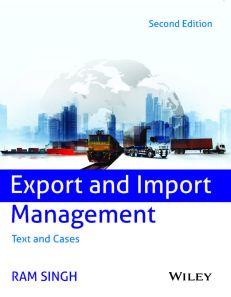Export and Import Management: Text and Cases, 2ed
ISBN: 9789357461825
592 pages
Publication Year: 2023
For more information write to us at: acadmktg@wiley.com

Description
In today’s globalized world, both export and import (EXIM) are vital to the health and dynamism of developed as well as developing economies. In the contemporary highly volatile trading environment, the significance of foreign trade for a country like India cannot be underestimated. It is important for our policymakers to leverage economic resources in all the areas of economic activities, including agriculture, manufacturing and services.
Chapter 1: Understanding Export–Import Operations
1.1 Introduction
1.2 Understanding the Concept of EXIM Operations
1.3 Differences between Domestic and EXIM Business
1.4 Preparing for EXIM Operations
1.5 Elements of Success in EXIM Operations
1.6 Importance of EXIM Trade to Nation
1.7 Importance of EXIM Trade to Industry
1.8 Managing Risks in EXIM Operations
1.9 Advantages and Disadvantages of EXIM Operations
1.10 Summary
Chapter 2: International Trading Environment
2.1 Introduction
2.2 Appraising International Trading Environment
2.3 Minimizing Implications of Trading Environment on Business
2.4 Summary
Chapter 3: Direction and Composition of India’s Foreign Trade
3.1 Introduction
3.2 Evolution of India’s Foreign Trade
3.3 Direction of India’s Foreign Trade
3.4 Composition of India’s Foreign Trade
3.5 Future of India’s Foreign Trade
3.6 Summary
Chapter 4: E-Commerce and Trade Information for Exporters
4.1 Introduction
4.2 Understanding E-commerce and E-business
4.3 Advantages of E-commerce
4.4 Essentials for Venturing into E-commerce Business
4.5 Procedure for Exports through E-commerce
4.6 Trade Information System for Exporters
4.7 Summary
Chapter 5: Legal Formalities for Getting Started in Foreign Trade
5.1 Introduction
5.2 Organizing for International Business
5.3 Understanding Tariff Classification System
5.4 Preparing for EXIM Business
5.5 Regulatory Requirement for Getting Started
5.6 Summary
Chapter 6: Product Selection and Adaptation for International Markets
6.1 Introduction
6.2 Concept of Product for International Markets
6.3 Export Product Planning
6.4 Designing the Products for International Markets
6.5 Selection of Product for Export
6.6 International Product Policy: Standard versus Adapted Product
6.7 Leveraging Product Life Cycle Stages in Exports
6.8 Summary
Chapter 7: Regulation of Foreign Trade in India
7.1 Introduction
7.2 Legal Dimension of Foreign Trade
7.3 Foreign Trade (Development and Regulation) Act, 1992
7.4 General Provisions Regarding Imports and Exports
7.5 Foreign Exchange Management Act, 1999
7.6 Export (Quality Control and Inspection) Act, 1963
7.7 Customs Act, 1962
7.8 Summary
Chapter 8: Understanding INCOTERMS 2020
8.1 Introduction
8.2 Factors Influencing the Choice of Delivery Terms
8.3 Purpose and Scope of Shipping Terms
8.4 Various Types of INCOTERMS
8.5 Applicable INCOTERMS in Different Modes of Transportation
8.6 INCOTERMS and Transfer of Risks
8.7 Leveraging Payment Mode with INCOTERMS
8.8 Choosing INCOTERMS for International Trade Deal
8.9 Summary
Chapter 9: International Sales Contracts
9.1 Introduction
9.2 Harmonization of Rules on International Sales of Goods
9.3 ISCs: The Legal Dimensions
9.4 Elements of ISC
9.5 Professional Tips for Incorporating Sales Contract
9.6 Preparation of the Export Sales Contract
9.7 Summary
Chapter 10: Processing of an Export Order
10.1 Introduction
10.2 Formation of an Export Order
10.3 Negotiation, Receipt and Acknowledgement of an Export Order
10.4 Scrutiny, Examination and Clarification of an Export Order
10.5 Steps in Processing of an Export Order
10.6 Post-export Documentation for Realizing Payments and Claiming Benefits
10.7 Summary
Chapter 11: Export-Import Documentation
11.1 Introduction
11.2 Legal Framework for EXIM Documentation
11.3 Role of EXIM Documentation
11.4 Aligned Documentation System
11.5 Various Aspects of Export Documentation
11.6 Trade Documentation Practices in India
11.7 Summary
Chapter 12: Pre-Shipment Export Credit Scheme
12.1 Introduction
12.2 Need for Export Finance
12.3 Export Financing Facilities
12.4 Pre-Shipment Finance for Exports
12.5 Pre-Shipment Credit in Foreign Currency (PCFC)
12.6 Special Cases of Pre-Shipment Financing
12.7 Summary
Chapter 13: Post-Shipment Export Finance Scheme
13.1 Introduction
13.2 Need for Post-Shipment Finance
13.3 Post-Shipment Finances Scheme
13.4 Mechanism of Disbursal Post-Shipment Finance
13.5 Special Cases of Post-Shipment Financing
13.6 Gold Card Scheme for Exporters
13.7 Interest Equalization Scheme
13.8 Summary
Chapter 14: Methods of Payment
14.1 Introduction
14.2 Understanding the Risk Matrix in Payment Mode
14.3 Factors Affecting Choice of Payment Mode
14.4 Various Modes of Payment
14.5 Methods of Fund Transfer
14.6 Summary
Chapter 15: Credit Insurance Policies and ECGC
15.1 Introduction
15.2 Growing Need of Credit Insurance
15.3 Credit Insurance Policies of EGCC
15.4 Basic Principles of Credit Insurance
15.5 Procedure for Making a Claim
15.6 Summary
Chapter 16: Duty Drawback Claim Procedure
16.1 Introduction
16.2 Duty Drawback Defined
16.3 Regulatory Framework for Duty Drawback
16.4 Drawback under Section 74: Policy and Procedure
16.5 Drawback under Section 75: Policy and Procedure
16.6 Summary
Chapter 17: Export Promotion Measures
17.1 Introduction
17.2 Export Promotion in India
17.3 Promotional Measures for Boosting Exports
17.4 Summary
Chapter 18: Quality Control and Pre-Shipment Inspection in Exports
18.1 Introduction
18.2 Quality Control Defined
18.3 Role of Quality Control in Exports
18.4 Methods of Quality Control
18.5 Quality Control Measures in India
18.6 EIC of India
18.7 Inspection Process for Exportable Cargo
18.8 Summary
Chapter 19: Dedicated Export Enclaves
19.1 Introduction
19.2 Concept of Dedicated Export Enclaves
19.3 Types of Dedicated Export Enclaves in India
19.4 Performance of Dedicated Export Enclaves in India
19.5 Procedure for Approval of an EOU
19.6 Role of Development Commissioner in Administration of EOUs
19.7 Process and Procedure of Customs Bonding of an EOU
19.8 Import/Procurement by EOUs
19.9 Summary
Chapter 20: Special Economic Zones in India
20.1 Introduction
20.2 Concept of SEZs
20.3 Procedural Formalities for Setting Up SEZs
20.4 Administrative and Institutional Set-Up of SEZ
20.5 Incentives and Facilities to the SEZs
20.6 Present Debate on SEZ
20.7 Summary
Chapter 21: Legal Framework of Customs Law
21.1 Introduction
21.2 Historical Overview of Customs in India
21.3 Meaning of Customs Duty
21.4 Scope and Coverage of Customs Law
21.5 Commonly Used Terms in Customs
21.6 Online System of Customs Clearance under ICEGATE
21.7 Summary

